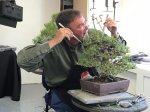Thanks, Oso!
Yes, I was totally wrong about the 10cm measurement for Japan! Lol!!!
And, yes, Smoke knows them!
A bit more about Shonin...
As us old guys get older, it's harder and harder to pick up the big trees and pots of the big Imperial Masterpiece trees. Smaller trees are far easier to pick up and mess with. So, Shohin have long been an old man's game.
But, a single Shohin, as perfect as it may be, just doesn't have the the visual elements a big tree has. There's just not enough to look at to hold anyone's attention for as long as a full sized bonsai.
So, they invented "Shohin box stands" as a way to fill as much space, vertically and horizontally as a big bonsai. Then they added the "rules", such as no two varieties should be the same in the display. Well, let me take that back! There are no rules! At least, no agreed upon, universally accepted, written, undisputed, rules. Except maybe the size (height) rule. And, old men, being old men, like to show off their little treasures, like fancy Shohin stands and jittas. And fancy little pots.
So, Shohin and Shohin display grew to more than just having small trees. It became a "game within a game" so to speak.
Now I didn't understand all this at first. Heck, I just thought "Shohin" meant its a small tree. But as I learned more (and I'm still learning) I found there are all these nuances that make it continually interesting and challenging.
Yes, I was totally wrong about the 10cm measurement for Japan! Lol!!!
And, yes, Smoke knows them!
A bit more about Shonin...
As us old guys get older, it's harder and harder to pick up the big trees and pots of the big Imperial Masterpiece trees. Smaller trees are far easier to pick up and mess with. So, Shohin have long been an old man's game.
But, a single Shohin, as perfect as it may be, just doesn't have the the visual elements a big tree has. There's just not enough to look at to hold anyone's attention for as long as a full sized bonsai.
So, they invented "Shohin box stands" as a way to fill as much space, vertically and horizontally as a big bonsai. Then they added the "rules", such as no two varieties should be the same in the display. Well, let me take that back! There are no rules! At least, no agreed upon, universally accepted, written, undisputed, rules. Except maybe the size (height) rule. And, old men, being old men, like to show off their little treasures, like fancy Shohin stands and jittas. And fancy little pots.
So, Shohin and Shohin display grew to more than just having small trees. It became a "game within a game" so to speak.
Now I didn't understand all this at first. Heck, I just thought "Shohin" meant its a small tree. But as I learned more (and I'm still learning) I found there are all these nuances that make it continually interesting and challenging.




